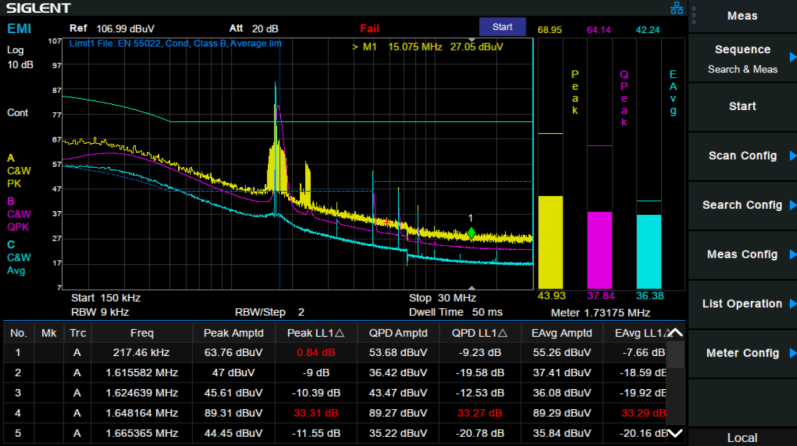EMC/EMI

In an increasingly wireless world, electronic devices need to communicate clearly and reliably without interference from other systems or external signals.
This is where Electromagnetic Compatibility (EMC) becomes crucial. EMC ensures that devices can operate in their intended environments without generating, or being affected by, unwanted electromagnetic interference (EMI). For companies developing advanced electronic products, achieving EMC compliance is not just a regulatory requirement; it’s a fundamental challenge that impacts performance, reliability, and user satisfaction.
The Dual Challenge: Performance vs. Interference
Antenna design faces a delicate balance. On the one hand, antennas must achieve high sensitivity and broad bandwidth to ensure strong signal reception and transmission across multiple frequencies. On the other hand, they must be protected from interference that can distort signals or even cause communication failures. As devices become more compact and densely packed with electronic components, the risk of EMI increases dramatically, especially in industries like automotive, telecommunications, IoT, and medical devices, where uninterrupted wireless communication is critical.
Quarterwave understands these challenges and offers solutions specifically designed to tackle the EMC issues that antenna systems face. Our expertise in Ultra-Wideband (UWB) technology allows us to design antennas that deliver both broad frequency coverage and high resistance to EMI. With Quarterwave’s solutions, your products can communicate clearly, even in environments with high electromagnetic noise, ensuring both compliance with global EMC standards and optimal device performance.
Key Challenges in Antenna Design for EMC Compliance
Minimizing Electromagnetic Interference (EMI)
EMI can come from many sources, including nearby electronic components, power lines, or external devices operating on similar frequencies. Antennas must be designed to reject or filter out this interference while still maintaining signal integrity.
Quarterwave’s UWB antennas use advanced shielding techniques and materials to suppress unwanted signals, providing clear communication channels and reducing interference to a minimum.
Balancing Size, Form Factor, and Performance
As devices become smaller and more compact, there is less physical space for antenna placement, which can compromise performance. This is especially challenging in industries like IoT, where miniaturization is key, but antenna performance cannot be sacrificed.
At Quarterwave, we specialize in compact antenna designs that maximize performance in tight spaces, ensuring your products remain competitive without compromising their wireless communication capabilities.
Achieving Multi-Frequency Operation
Many modern devices need to operate across a wide range of frequencies (e.g., Wi-Fi, Bluetooth, cellular, etc.). This requires antennas capable of multi-band functionality, which can be challenging when it comes to minimizing cross-band interference.
Our multi-band UWB antennas are engineered to provide seamless communication across diverse frequencies while maintaining compliance with EMC requirements, reducing signal distortion across multiple bands.
Compliance with Global Standards
EMC standards vary by region, and designing antennas that meet stringent regulatory requirements (e.g., FCC, CE) is essential for product certification and market access. Non-compliance can lead to costly delays, redesigns, or product recalls.
Quarterwave’s in-depth knowledge of global EMC regulations ensures that our antenna solutions not only meet, but exceed the necessary certifications, streamlining the compliance process and helping your product reach the market faster.
Professional RF probes made by Quarterwave

Quarterwave not only performs precompliance measurements, but also manufactures its own measurement equipment, such as RF probes, which are superior to the probes available on the market.
RF probes are specialized tools used for making accurate and minimally invasive measurements in RF and microwave circuits. They play a crucial role in ensuring the integrity and performance of high-frequency electronic systems.
Conducted Emission according EN 55022, Class B

Quarterwave can conduct EM Measurements according to all applicable standards like EN 55022 (CISPR 22).
Quarterwave offers a diverse array of measuring equipment to fulfill this purpose, including a test receiver equipped with matching detectors and filters, such as Avg and Quasi Peak.
Why Choose Quarterwave?
At Quarterwave, we don’t just design antennas—we engineer complete EMC solutions tailored to your product’s specific needs. By focusing on wireless technology and utilizing cutting-edge materials and techniques, we provide antennas that are robust, efficient, and highly resistant to electromagnetic interference. Our designs ensure that your devices can perform reliably in the real world, no matter how challenging the electromagnetic environment.
With Quarterwave’s antenna solutions, you can confidently move forward with products that not only comply with EMC regulations but also offer superior wireless performance, giving you a competitive edge in the market.
© 2024 Designed by Quarterwave. All rights reserved.
Wir benötigen Ihre Zustimmung zum Laden der Übersetzungen
Wir nutzen einen Drittanbieter-Service, um den Inhalt der Website zu übersetzen, der möglicherweise Daten über Ihre Aktivitäten sammelt. Bitte überprüfen Sie die Details in der Datenschutzerklärung und akzeptieren Sie den Dienst, um die Übersetzungen zu sehen.
